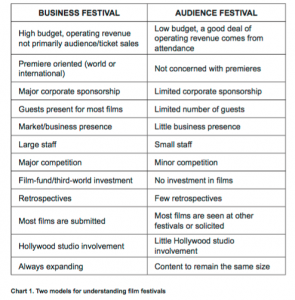
Why Film Festivals Matter: Festivals as “Part of a Film’s Life”
In a meeting with Dartmouth students in summer 2016, Mark Adams, Artistic Director of the Edinburgh International Film Festival (EIFF), explained how he views a film festival as “part of a film’s life.” A festival, he went on, “serves a film’s starting point” before it makes its way to audiences. Adams’ remarks are indicative of a trend in scholarly discussions about the role of film festivals in the industry and why festivals exist. Many of these conversations are focused on issues of distribution. In a competitive market that is driven by commercial objectives and molded by the strategies of major production companies, it is difficult for non-mainstream films to find theatrical distribution and audience exposure. No doubt film festivals are at crossroads, but they are still providing solutions to this problem. Festivals are important not only in maintaining an exhibition platform for independent filmmakers and auteurs, but also in maintaining an audience for art and auteur cinema.
Several scholars, such as Gideon Bachmann (2000), make a distinction between “wholesale” and “retail” film festivals. “Wholesalers” act primarily as markets for sales agents to sell films. “Retailers,” on the other hand, are essentially exhibitions for audiences.
As Bachmann points out, an important difference between “wholesale” festivals and “retail” festivals is that “wholesale” festivals cater to the greater global cinema market, while “retail” festivals serve a more local function, showing films unavailable in regular theaters to people from a region. Comparably, Mark Peranson (2008) argues that festivals have become a parallel method of film distribution, distinguishing between “business” festivals and “audience” festivals:

(Peranson, 27)
Peranson’s distinction between “business” and “audience” festivals parallels Bachman’s distinction between “wholesalers” and “retailers” festivals. This distinction has important implications for film distribution and audience exposure. As Christian Gaines (2008) suggests in his two part article, Do Festivals Matter, the split between wholesale and retail festivals creates a new, “festival acquisition model” of distribution. Both Bachmann and Gaines suggest festivals themselves have become an alternative distribution method for smaller productions.
In Bachman and Gaines’ “festival acquisition model,” sales agents pursue smaller-scale revenue opportunities that are created through film festivals and associated regional distribution. Peranson notes that the defining actor in this new festival environment is the sales agent—”an entity that didn’t exist a few decades ago” (Penarson, 29). A sales agent is responsible for selling films for domestic distribution, either theatrically, on DVD, or via direct downloads. Sales agents decide which festivals a film will play at, and often demand screening fees from festivals. Within such a system, the best way for festivals to attract the films that they want is by offering cash. As Peranson explains, “essentially there seems to be a kind of a core/periphery system of exploitation, where the ever-increasing screening fees are becoming more and more essential to keep the system afloat” (Penarson, 32).
The importance of sales agents in this landscape is indicative of the growing role of business in the film industry. While festivals have always catered to film industries by offering professional networking opportunities and organizing markets, as Marijke DeValk¹ argues, industry-oriented activities have become increasingly central (Devalk, 78). This may be problematic for low-budget festival organizations, as sales agents ask for screening fees and revenues from ticket sales. However, as Bachmann argues, the trend can be beneficial for small budget independent and filmmakers. Where wholesale events attract professionals from far away, audiences of retail festivals do not travel — the festivals come to them. This is important , as DeValk notes, because festivals create a market for art cinema and “reproduce” independent filmmakers. That is, because festivals exist and flourish, filmmakers will continue to produce films for this exhibition outlet (DeValk, 78).
Furthermore, festivals are an important exhibition platform for independent productions because most features never reach the commercial screen. According to the independent cinematography office, only about ten percent of feature films produced each year see the inside of the cinema. Instead, most are distributed commercially on TV and video. While exhibition platforms are convenient, they do not allow for a film to be properly seen or appreciated. Images can become dubbed and grainy, and do little justice to the intentions of the filmmakers. Festivals are many films’ chance to be seen on the big screen. In doing so, festivals “reproduce the festival audience” by cultivating a disposition to art cinema and allowing films to be seen as their makers intended (DeValk 78).
In this way, film festivals do appear to be an important “part of a film’s life.” Paradoxically, while festivals reveal the growing influence of “business” that goes on between professionals behind closed doors, they also play an important role in opening up the industry to the public in bringing films to audiences. So long as the “wholesalers” are primarily markets, and the “retailers” exhibitors, the true staying power of festivals may depend on “retail” festivals providing an audiences with an alternative to the multiplex. The shrinking number of art-film theaters, as a result of competition from cable television, home-video and online streaming lends an increasing importance to festivals. “Retail” film festivals are a more important exhibition platform than most. Festivals maintain a market for independent productions and art cinema. In showing more films to more people, festivals foster a future audience for serious films.
Comments are closed, but trackbacks and pingbacks are open.